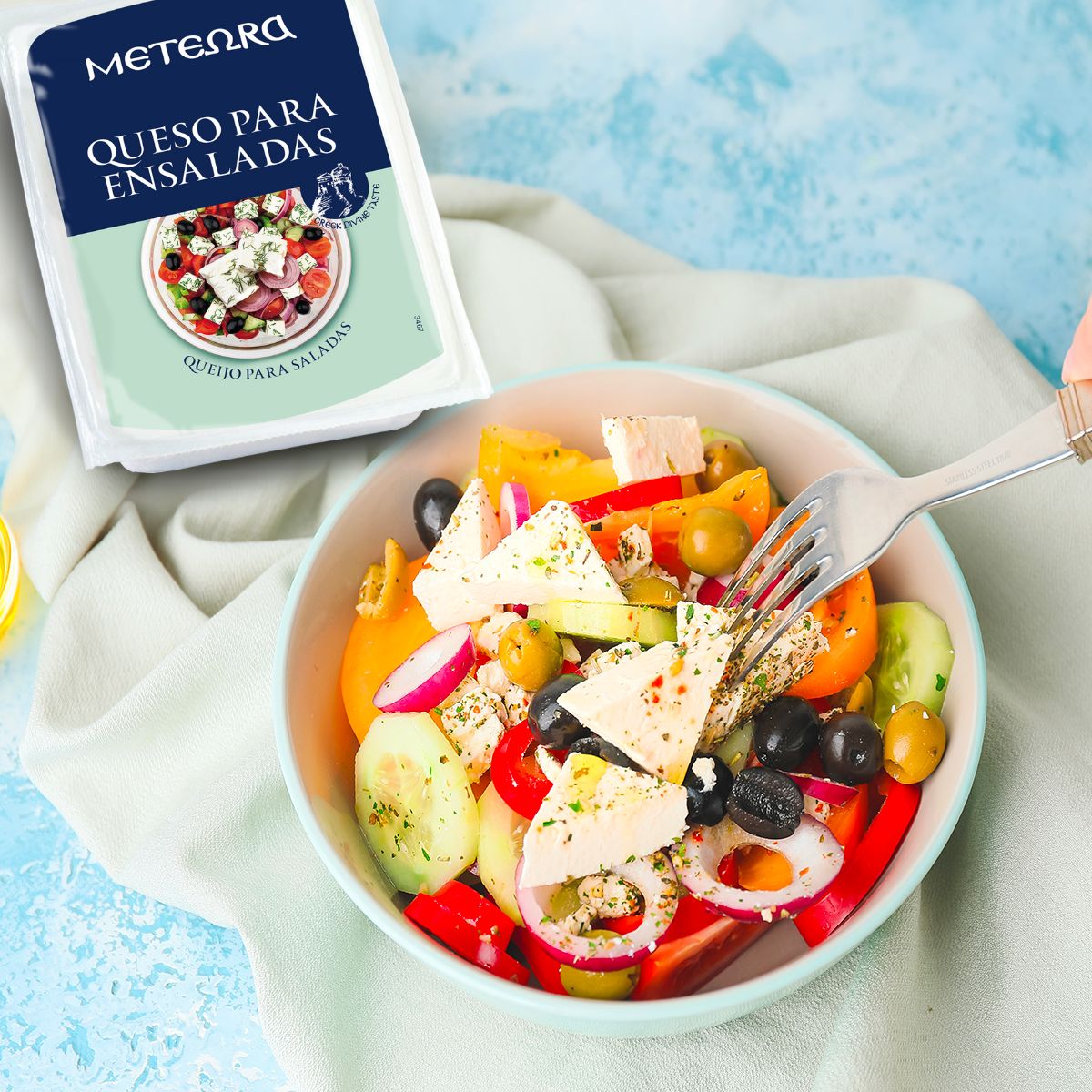Feta cheese has conquered palates all over the world. It represents the experience and knowledge of a long history dating back to ancient Greece. The name feta dates back to the 17th century and refers to the way the cheese is cut.
The preparation of this cheese is an artisanal process that follows specific steps to achieve a distinctive flavour, texture and white colour.
What is feta cheese?
Feta cheese is a white, salty, crumbly cheese from Greece. It is a dairy product traditionally produced from sheep’s milk or a combination of sheep’s and goat’s milk. Feta cheese has, over the years, gained popularity around the world and is known for its distinctive taste and versatility in cooking.
One of the characteristics that make this cheese special is its texture. It is a white, crumbly cheese that is matured in brine. This provides a balance between salty and acidic. All this makes it a perfect complement to various culinary preparations.

Types of feta cheese
Although it is a dairy product originating from Greece, there are variations of the cheese beyond its borders. Some of the types of feta cheese that can be found on the market are the following:
- In olive oil. This is a cheese that after ripening in brine is placed in jars and covered with olive oil for preservation. This provides additional nutrients and flavours to the cheese.
- Smoked feta cheese. In some cases, feta cheese is smoked to add a smoky flavour profile to the characteristic taste of the cheese.

- Cow’s milk. Produced from cow’s milk. This type of feta tends to be milder and less salty compared to traditional sheep feta.
- Marinated feta cheese. This is a variant marinated with herbs or spices to add a distinctive flavour. Sometimes olives, garlic or peppers, among others, are added.
- Sheep feta cheese. This variant is made only with sheep’s milk, which offers a more pronounced flavour and creamier texture than regular feta.
- Aged feta. This variant of feta cheese is left to mature for longer periods of time. This results in more intense and complex flavours and a firmer texture.
- Vegetarian feta. For vegetarians who do not want to lose this product in their diet, some producers use vegetable rennet instead of animal rennet to make it suitable.

What are the benefits of eating feta cheese?
In addition to being a food that delights the palate, feta cheese provides rich nutritional benefits. This makes it a healthy product in a balanced diet. These are some of the advantages of consuming feta cheese.
Vitamins and minerals
Feta cheese also provides essential vitamins and minerals, such as vitamin A, B6, B12, zinc and phosphorus, which play crucial roles in metabolic function and overall health.
Source of calcium
It is an excellent source of calcium that benefits the bone and dental health of the human body. Calcium is essential for maintaining strong bones and supporting clotting, muscle tissue and the nervous system. This mineral can help prevent bone disease.
High-quality protein
Contains high quality proteins essential for cell repair and growth that support the immune system, acting as enzymes and antibodies. This makes it a nutritious choice for those looking to increase their protein intake. In addition, because it contains animal protein, it helps to reduce the risk of diabetes.

Natural probiotics
As with other fermented cheeses, feta cheese contains beneficial probiotics that promote digestive health by balancing the intestinal flora.
Reduce cardiovascular risk
When consumed in moderation, feta cheese can be part of a diet that helps reduce cardiovascular risk. Its content of essential fatty acids and other bioactive compounds contribute to this goal.
Dishes in which to use feta cheese
The versatility of feta cheese makes it a star ingredient in a wide variety of dishes. From salads to main dishes and appetizers, here are some creative ideas for incorporating feta cheese into your cooking:
- Salads. One of the most common uses for feta cheese is in salads. This type of cheese is the perfect partner to add to a mix of lettuce, tomato, cucumber, onion, olives, etc.
- Pastas and risottos. For a mix of cultures and flavours, feta cheese adds a Greek touch to typical Italian dishes such as pasta and risotto. Adding the cheese at the end of cooking adds a creamy and salty touch.
- Sauces. Because it is such a versatile product, it can be used to prepare fresh sauces or as a topping for grilled meats, roasted vegetables or as a dip.
- Seafood dishes. It can be combined with seafood dishes. Mixing feta cheese with these dishes adds Mediterranean flavours.
- Cakes and pies. Feta cheese fits perfectly into savoury pies and pasties. It can be combined with multiple ingredients to create a delicious mix.
- For creative breakfasts. The integration of this type of product into breakfasts is becoming more and more common. Thanks to its nutrients, texture and robust taste, you can experience breakfasts with a twist by adding feta to pancakes, omelettes, toast or wraps.
Premium feta cheese
This crumbly white cheese is highly appreciated in Mediterranean kitchens for its particular flavour and nutritional benefits. To taste an authentic Greek feta cheese, it is essential to have a pack of the premium brand METEORA, one of Codina Foods’ suppliers for horeca.
METEORA is the leading Greek cheese manufacturer. It produces Greek cheeses of the highest quality with the characteristic unique taste of Greek cuisine. Thus bringing the benefits of the Mediterranean diet to the whole world.


